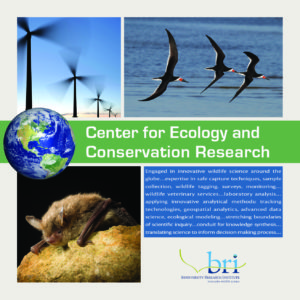Fifth Conference of the Parties (COP-5)
 The fifth meeting of the Conference of the Parties to the Minamata Convention on Mercury (COP-5) took place in Geneva, Switzerland, from 30 October to 3 November 2023.
The fifth meeting of the Conference of the Parties to the Minamata Convention on Mercury (COP-5) took place in Geneva, Switzerland, from 30 October to 3 November 2023.
Special Event: Mercury in Cosmetics
BRI was part of a special event: Mercury in Cosmetics: More than Meets the Eye, at COP5. With the global cosmetics market expanding, growing 14 percent in 2022, and the majority of skin lighting products exceeding the limits set by the Minamata Convention on Mercury, eliminating the use of mercury within skin lightening products (SLPs) is critical to meet the needs of the Convention.
This session was co-organized by the Global Environment Facility and United Nations Environment Programme and sought to question the promotion and normalization of skin lightening and confront the perpetuation of harmful cultural norms. Learn more here.
Global Mercury Impact Synthesis: Impacts of Climate on Mercury Fate and Processes in the Southern Hemisphere
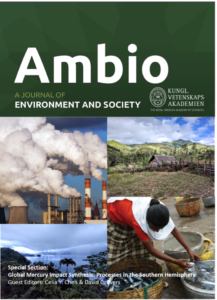 To support implementation of the Minamata Convention on Mercury and COP-5, the mercury science community produced synthesis papers summarizing current knowledge that is relevant to articles of the Convention. In association with the 15th International Conference on Mercury as a Global Pollutant (ICMGP), five papers by leading mercury scientists and policymakers were published in a special section in the journal Ambio in 2023. These synthesis papers summarize the current understanding of mercury and ASGM, impacts of mercury on human health, effects of climate change on mercury cycling, and the natural and anthropogenic mercury sources and processes in the Southern Hemisphere. Sharing and summarizing data enhances communication among a diverse group of researchers, managers, and policymakers, which allows for scientific findings to help better inform policy decisions. Read the special issue here.
To support implementation of the Minamata Convention on Mercury and COP-5, the mercury science community produced synthesis papers summarizing current knowledge that is relevant to articles of the Convention. In association with the 15th International Conference on Mercury as a Global Pollutant (ICMGP), five papers by leading mercury scientists and policymakers were published in a special section in the journal Ambio in 2023. These synthesis papers summarize the current understanding of mercury and ASGM, impacts of mercury on human health, effects of climate change on mercury cycling, and the natural and anthropogenic mercury sources and processes in the Southern Hemisphere. Sharing and summarizing data enhances communication among a diverse group of researchers, managers, and policymakers, which allows for scientific findings to help better inform policy decisions. Read the special issue here.
Pre-COP Virtual Side Events
COP-5 events are an informal platform for Parties and observers to share information and bring knowledge to advances in technology, research, and policy to the attention of Parties and to the global community that the Convention serves. BRI was part of three online side events, listed below. Online events are one hour in duration and take place virtually using the WebEx platform.
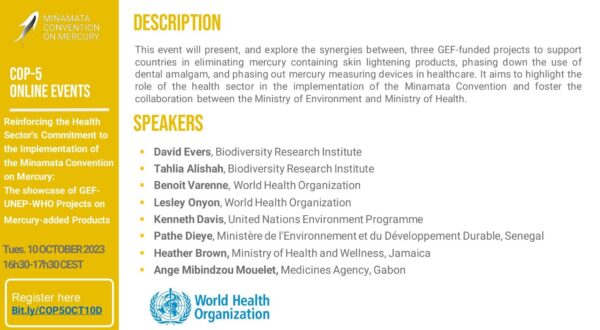
Reinforcing the health sector’s commitment to the implementation of the Minamata Convention on Mercury: The showcase of GEF-UNEP-WHO projects on mercury-added products, 10 October, 2024. 16h30-17h30 CEST.
_______________________________________________________________________________________________
 Navigating uncharted waters towards Mercury-Free SIDS, 10 October, 2024. 17h45-18h45 CEST.
Navigating uncharted waters towards Mercury-Free SIDS, 10 October, 2024. 17h45-18h45 CEST.
________________________________________________________________________________________________
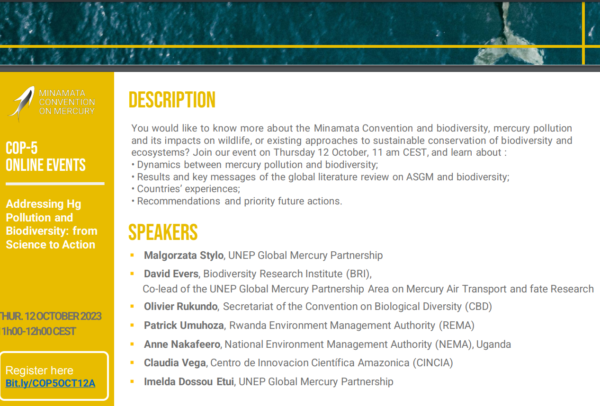 Addressing Hg pollution and biodiversity: from science to action, 12 October, 2024. 11h00-12h00 CEST. Register here. The UNEP Global Mercury Partnership together with its partners, including the Biodiversity Research Institute (BRI) and related stakeholders, is holding this side event as an opportunity to:
Addressing Hg pollution and biodiversity: from science to action, 12 October, 2024. 11h00-12h00 CEST. Register here. The UNEP Global Mercury Partnership together with its partners, including the Biodiversity Research Institute (BRI) and related stakeholders, is holding this side event as an opportunity to:
- Provide an overview of existing dynamics between mercury pollution, biodiversity, and ecosystem services;
- Present key highlights of the recent global literature review on ASGM and biodiversity;
- Showcase countries’ experiences, if possible, in key regions – Latin America, Africa and Asia – by sharing concrete synergetic initiatives across biodiversity and mercury pollution clusters;
- Initiate exchanges on recommendations and priority future actions.
BRI’s Contribution to the Minamata Convention
As experts in the field of mercury science, BRI researchers were invited by U.S. government officials to participate as a nongovernmental organization (NGO) during the negotiating process of the Convention. The meetings of the International Negotiating Committee (INC) that preceded and have continued since the adoption of the Convention include delegates from more than 140 countries and numerous NGOs interested in reducing mercury pollution. BRI has participated in five of the first seven INC meetings, and each subsequent Conference of Parties.
BRI serves as co-lead of the UN Environment’s Mercury Air Transport and Fate Research partnership area. As a co-lead, BRI assists developments for a globally coordinated mercury monitoring and observation system. In addition, BRI aids three UN agencies in implementation of Minamata Convention Initial Assessment (MIA) activities in many countries, as (1) an Executing Agency with UNIDO, (2) an International Technical Expert with UNDP, and (3) an International Technical Expert with UN Environment. These MIA activities are designed to assist countries with developing strategies for ratifying and ultimately implementing the Convention.
BRI Science Communication
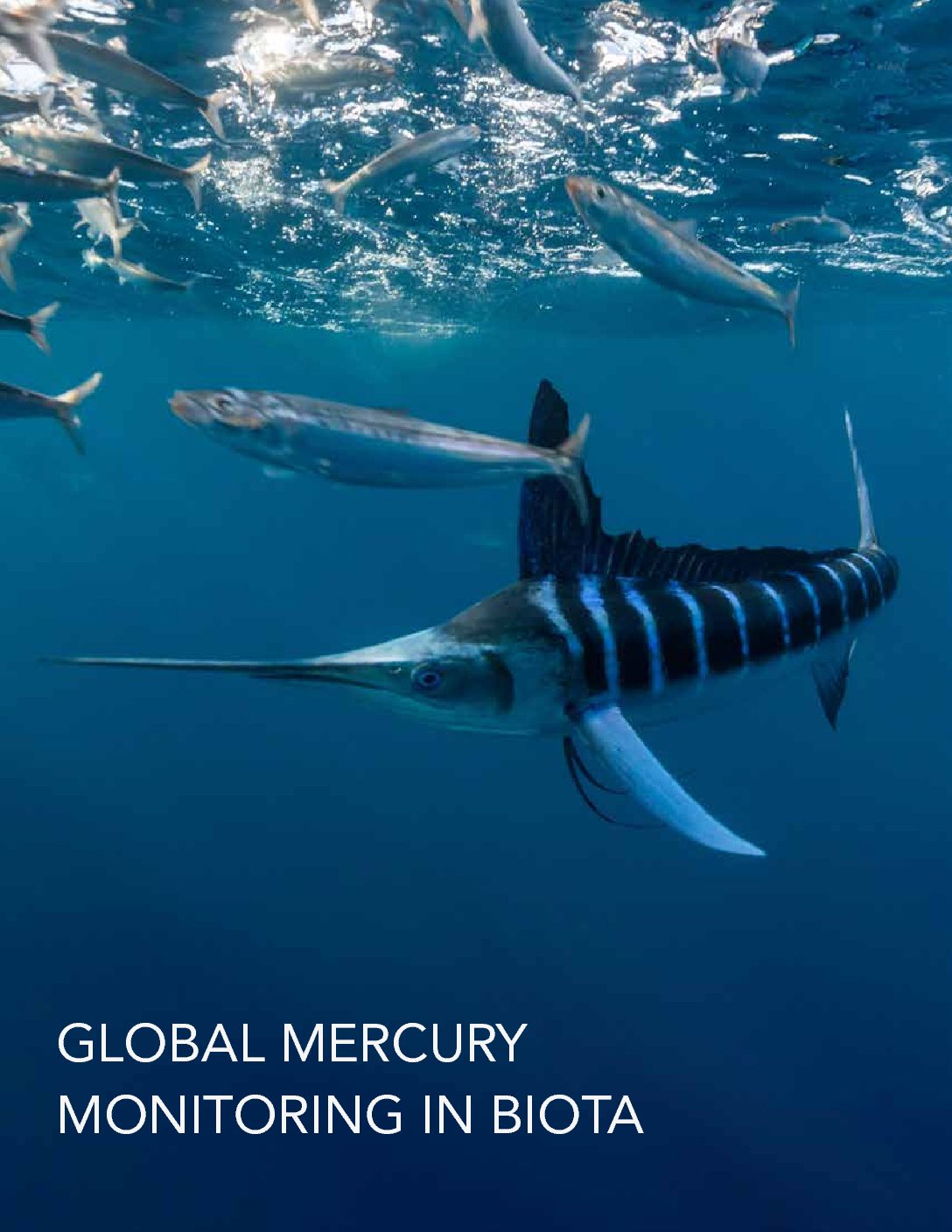
Global Mercury Monitoring in Biota (2019)
Technical Information Report on Mercury Monitoring in Biota (2019)
Monitoring mercury in biota (plants and animals) provides a pathway for understanding spatial gradients, temporal trends, and environmental magnitude of concern that cannot be ascertained in air, water, or sediment. Emphasizing upper trophic level biota for monitoring ultimately provides a confident ability to asess whether the global input of anthropogenic mercury into the environment is safe or harmful to fish, wildlife and humans. Learn more in our 8-page communications booklet or download our full technical report above.
In addition, download the UN Environment Programme’s summary brochure here.
Global Mercury Inventory Synthesis (2019)
Global Mercury Inventory Synthesis – Technical Report (2019)
This publication highlights the results of a pilot study that Biodiversity Research Institute, in collaboration with UN Environment, developed to examine and summarize the national mercury inventories of 43 countries that have completed the Minamata Initial Assessment process. This pilot study quantifies the relative contributions of sectors (ten primary source categories) to mercury emissions and releases, within a set of countries representing varied global regions and socio-economic backgrounds. Learn more in our 4-page communications booklet or download our full technical report above.
Mercury in the Global Environment presents data on mercury concentrations in marine and freshwater biota extracted from the GBMS database, as well as mercury data relative to global fisheries capture data from the Food and Agriculture Organization (FAO). Mercury concentrations from various taxa are presented and compared geographically. Together, these data help inform decision makers of species in which and locations where mercury presents a risk to human health and the environment. This report aids parties of the Minamata Convention on Mercury during their ratification and implementation processes.
Mercury in the Global Environment: Marine Mammals (2017)
Marine mammals migrate across the globe, either forgaging on the smallest of animals (krill) or prey on the largest, but all depending on uncontaminated food sources. Over the past century, mercury released through industrial processes has been entering and accumulating in the world’s oceans, putting marine mammals at risk. To help illustrate the impacts of methylmercury biomagnification (increased toxicity as toxins moves up the food web) and bioaccumulation on marine mammals, we have identified five particularly affected groups: toothed whales, baleen whales, pinnipeds (seals and walruses), people (in particular, aboriginal subsistence communities), and the polar bear.
Mercury in the Global Environment: Tuna (2018)
Tuna are regularly listed on fish consumption advisories. Yet, tuna are consistently among the top five commodities in the global fish market. Skipjack, albacore, and yellowfin are most commonly processed for canned products, while bluefin are valued for direct consumption. This publication summarizes GBMS and FAO data from nine tuna species, and examines trends by ocean basin through the lenses of human and environmental health.
The Minamata Convention aims to reduce mercury use in products and dental amalgam. This booklet focuses on mercury-added products, as outlined in Article 4, which prohibits the manufacture, import, and export of specific mercury-added products by 2020. In addition, it discusses Article 11, which addresses mercury wastes.
Fish and wildlife provide important information on the risks and impacts of mercury pollution on environmental and human health. Biomonitoring is the process of assessing the health of organisms and ecosystems through changes in mercury risk and exposure over time. This publication describes biomonitoring efforts outlined in Article 19 of the Minamata Convention on Mercury, which lists fish, sea turtles, birds, and marine mammals as organisms to be monitored.
Mercury Tracking Fliers

Learn how you can participate in global efforts to track mercury in cosmetics, humans, and seafood in your country. Each brochure outlines the sampling process and highlights how participation will help countries meet requirements of the Minamata Convention on Mercury.
Phasing Out Mercury-added Products: Skin Lightening Products and Other Cosmetics
Local, Regional and Global Biomonitoring: People
Photo Credits: Header photo © BRI-Tim Divoll. Study Subjects: Northern long-eared bat © Bat Conservation International; Eastern small-footed bat © BRI-Jonathan Fiely; Indiana bat © BRI-Jonathan Fiely, River otter © iStock; Mink © BRI-Jonathan Fiely; Harbor seal © Sharon Fiedler. In the field © BRI; Banded bat © BRI- Jonathan Fiely; Tracking © BRI-Dave Yates; Otter family © BRI- Dave Yates, Bat cave © BRI.

